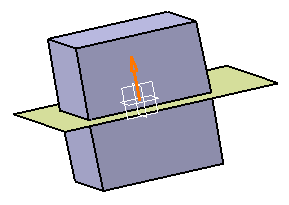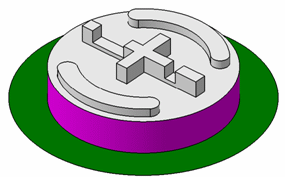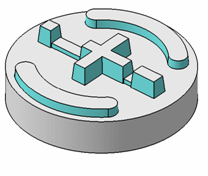 |
The Automatic draft
capability speeds up
the draft angle process to manage the whole part in one shot and to
capture higher level semantic. In case you need to draft
the whole faces of the part, you just need to adjust the angle value
according to your needs and then run the capability.
In case you do not want to draft the whole part, optionally select what we call
"functional faces": these
faces identify the faces you do not want to draft.Using AutoDraft is therefore a good way of drastically reducing the time
spent on drafting.
|
 |
Open the AutoDraft.CATPart document. |
 |
-
Click Automatic Draft
 in the Advanced Dress-up Features toolbar
in the Advanced Dress-up Features toolbar
 . .
The Automatic Draft Definition dialog box
appears.
-
Optionally, click More to expand the dialog
box and display images helping you define your specifications.
-
The Mode field lets you
specify a mode among two possible ones:
- Add material: adds the minimum amount of material to
the part to perform the draft operation. This implies
that the part will be enlarged on the parting element. The
neutral faces are automatically computed in
this case, detected among the body faces, on the side defined by
the pulling direction.
- Remove material: removes the minimum amount of
material from the part to perform the draft operation.
This
implies that the part will be kept unchanged on the parting
element. So the neutral elements contain the parting element.
|
Help images reflect the computation mode you select. For
the purpose of our scenario, keep Add material.
-
Right-click on the Pulling direction field and set the
Pulling direction as Z Axis. The pulling
direction defines the side of the parting element to be drafted.

-
The Functional Faces field lists the
manufactured faces
that are not to be drafted. The selected faces turn
purple, indicating that they will not be drafted.
-
Keep 15deg as the draft angle value. The minimum angle
value between the surface of the part and the pulling direction is the
draft angle value.
-
Select Extrude.1 as Parting element.
-
Check OK to confirm.
A new dialog box appears, indicating the operation progress. In case you
want to interrupt the operation, just click Cancel.
-
The drafts are displayed in the
geometry area:
|
 |
- You cannot select a neutral element that is not intersecting the
face to draft.
-
You should provide a parting element large enough
in order to intersect the whole draft skin. Particularly, when material
is added the parting element can not be a set of faces from the body to
draft because it is not large enough.
-
The parting should also be a connex and finite
skin. This skin should be orientable.
-
The parting element is mandatory if the remove
material mode is chosen. It is often needed for add material mode it can
however be omitted if all the faces from the input body that cross the
parting are functional faces, like for example in this case (the
functional faces are the pink faces):


|
![]()